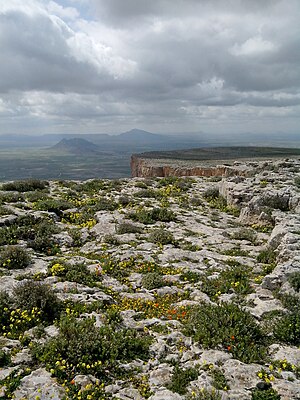Table de Jugurtha
| Table de Jugurtha | ||
|---|---|---|
|
Table de Jugurtha |
||
| height | 1271 m | |
| location | Tunisia | |
| Coordinates | 35 ° 44 '37 " N , 8 ° 22' 49" E | |
|
|
||
The mountain range in Tunisia , called Table de Jugurtha , is a maximum of 1271 m high and consists of a striking table mountain and other smaller peaks. The mountain range, consisting mainly of limestone , forms part of the Tunisian ridge ( dorsal ); it is badly washed out and furrowed from erosion. Abundant rainfall occurs only in the winter months November to February; Snowfalls are rare and melt quickly. The Table de Jugurtha was included in Tunisia's list of proposals for UNESCO World Heritage in 2017 .
location
The Table de Jugurtha massif is located about 7 kilometers (as the crow flies) east of the Algerian border near the small town of Kalâat Senan in the Kef governorate ; the city of Tunis is about 235 km (driving distance) to the northeast.
Ascent
A long asphalt road leads up to a height of about 1100 meters; the summit plateau, about one and a half kilometers away, is a popular vantage point with a wide view over northern Tunisia and into Algeria.
Flora and fauna
The vegetation is rather sparse and includes smaller flowering plants and grasses; the pine forests that were once probably at the foot of the mountain or on the mountain flanks have completely disappeared.
In contrast to the Djebel Chambi national park further south, the animal world has been pushed back by humans. Sometimes you can see eagles , vultures and peregrine falcons ; however, larger mammals are not present.
history
The steeply rising flanks made the mountain attractive as a place of retreat or refuge in earlier times. Numerous cistern basins carved into the rock plateau as well as grottos and wall remains of a fortress indicate a former human use. According to tradition, it is said to have occurred as early as 105 BC. The Numid king Jugurtha withdrew to the mountain before the attacking Romans ; he was captured during the siege and executed in Rome. The mountain was also used - perhaps even then - as a summer pasture for sheep and goats. A small mosque from more recent times can also be found here.
See also
Web links
- Table de Jugurtha - photos + brief information (French)
- Table de Jugurtha - Photos and brief information (English)
- Table de Jugurtha - video
Remarks
- ↑ The altitude information varies between 1255 and 1271 depending on the source
- ↑ La Table de Jugurtha à Kalaat-Senen. UNESCO World Heritage Center, accessed October 27, 2017 (French).


